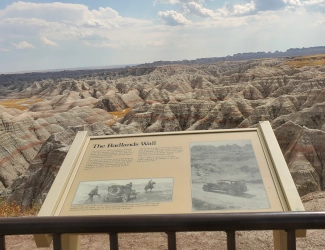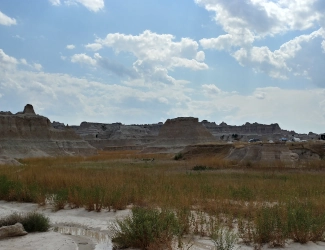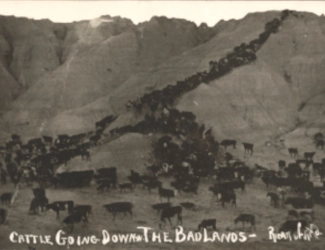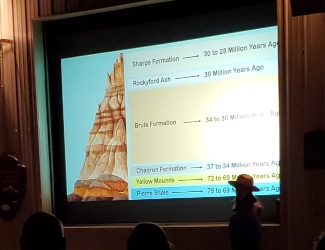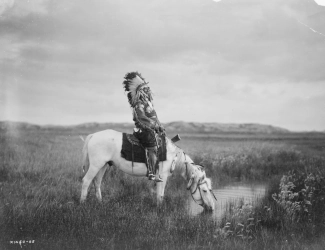
Photo above: Red Hawk, an Oglala warrior, in the Badlands north of the park, 1905, Edward S. Curtis. Courtesy Library of Congress. Right: Another beautiful, yet harsh landscape found while discovering the Tour Loop Road in the North Unit of the park, 2024, America's Best History.

Badlands National Park
Just to start with our meager observations of the park: stunning, moonscape, unique, like nothing else I've seen in the United States. If you were passing this prairie to limestone spire with deep canyons in the past, i.e. Native or European migration, it would have been foreboding. This was the place outlaws went to hide, or never return. But I am sure Architect Frank Lloyd Wright said it better in 1935 upon first sight, "... but I was totally unprepared for that revelation called the Dakota Bad Lands. What I saw gave me an indescribable sense of mysterious elsewhere -- a distant architecture, ethereal, an endless supernatural world more spiritual than earth but created out it." You've got to visit, even if you don't find part of the skull of an oreodant (prehistoric dog/sheep/goat like creature) as a teen on our fossil hike did.
Click here to Sponsor the page and how to reserve your ad.
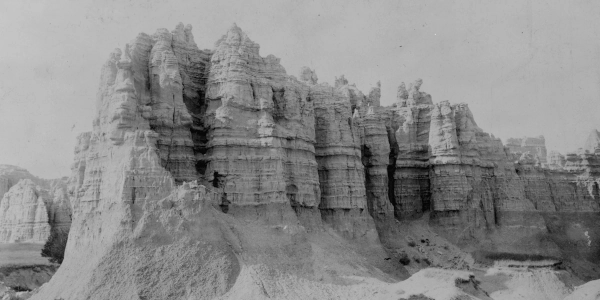
Badlands National Park Then
It does not seem possible that man could inhabit this land, but it has, for over eleven thousand years, although pretty certain there were few of them. They were mammoth hunters of course. Once the inland sea became more land, the Arikara tribe would hunt bison there, followed by the Lakota (part of the Sioux nation). With their Spanish horses, they dominated the region. And if there were Spanish to the south, it would not be long before additional white men would come; trappers, homesteaders who built sod houses, and bison hunters, who eradicated, almost, a species and took away the lifestyle of the Native American on the plains. The U.S. government signed the "Second Treaty of Fort Laramie," in 1868, promising that the land of the Badlands would forever be Sioux territory. Of course, that treaty was broken eleven years later. When a century later the United States offered compensation, the Sioux refused.
Photo above: Statuary buttes of the Badlands, 1896, John Alvin Anderson. Courtesy Library of Congress. Below: View of the spires and vegetation within Badlands National Park, 2024, America's Best History.
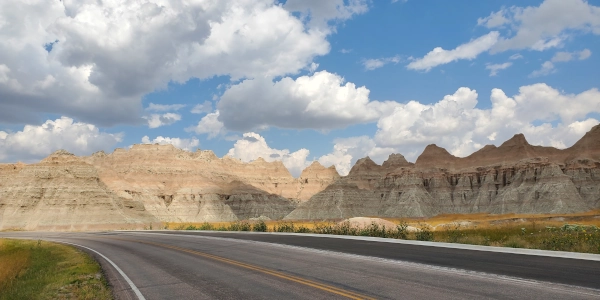
Badlands National Park Now
The park was authorized as a National Monument on March 4, 1929, but took ten years before it was established. It rose to national park status in 1978. Over one million visitors come each year to marvel at the stunning landscape and take part in ranger programs.
There are three sections to the park today. The North unit where the main Ben Reifel Visitor Center is located along with visitor amenities, including the Badland Loop Road. The South Unit, divided into the Stronghold Unit, including the seasonal White River Visitor Center, and the Palmer Creek Unit. The South Unit is co-managed by the National Park Service and the Pine Ridge Indian Reservation of the Oglala Sioux, on whose land, 133,300 acres, it resides.
Minute Walk in History
As stark a landscape as most will find on earth, the Badlands, with those limestone pillars rising from the prairie for one hundred or so miles, was once an inland sea that split North American in two. Take a look at how the landscape became lunar, how the variety of fossils, some fish fifty feet length, formed and can still be found. Through a variety of natural videos and ranger programs, you'll be amazed at how different this land looks from almost anywhere.
T-Shirts and Souvenirs

Badlands National Park T-Shirts and Souvenirs.
Badlands National Park
Things You Should Not Miss
1. Take the Fossil Walk. It's about seventeen miles inside the Northeast Entrance and on the left hand side heading west. Hopefully you'll get to take a guided walk into the Badlands proper or just a talk in the shaded wayside by a park ranger. Ask at the Visitor Center for when it is available, or explore on your own.
2. Stay around at night, even if you are lodging or camping farther outside the park than you'd like, for the night ranger talk, then Night Sky Program at the Amphitheater near the Ben Reiffel Visitor Center, Cedar Pass Lodge, and Cedar Pass Campground. It's a wonderful location to sit under the stars and hear about the park, and stars.
3. Take the Bandlands Loop Road. It is long, well over fifty miles, athough you can turn around, or take the Pinnacles exit prior to continuing toward the Sage Creek campground and area. The sites are spectacular. Your car might get mad at you about all the wayside stops.
